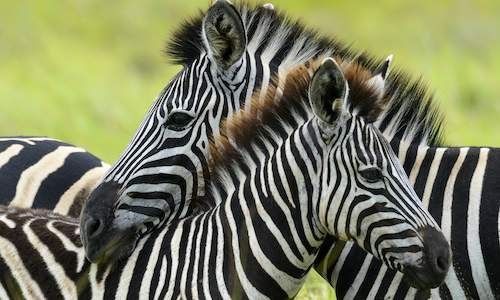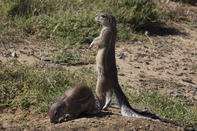
Mountain Ground Squirrel
Name
Mountain ground squirrel (Xerus princeps)
Appearance
The mountain ground squirrel, or the Kaoko ground squirrel, used to be considered a subspecies of the Cape ground squirrel but is now recognised as its own species. With a weight of 1.4 kg, it is larger than the Cape ground squirrel.
The mountain ground squirrel is a shiny light brown in colour on its upper body, with two white stripes running down either side. Rather than white, the teeth appear orange in colour. It has a characteristic bushy tail with three black bands, unlike the Cape ground squirrel which only has two, and a white underside.
In further comparison to the Cape ground squirrel, the mountain ground squirrel has finer body hair, a longer tail and longer hind feet.
Mountain Ground Squirrel Diet
The mountain ground squirrel feeds on foods that are high in quality, such as roots, bulbs, acacia seeds and green sprouting plants. They will climb about two meters into trees and bushes to collect berries, mopane plant lice and green leaves.
Mountain Ground Squirrel Breeding
After a gestation period of 48 days, females give birth to a litter of three, on average. Their breeding period in South Africa is usually during mid-summer, but may extend into winter.
Mountain Ground Squirrel Behaviour
The mountain ground squirrel is a diurnal species. They construct single burrows with only one nesting chamber between rocky outcrops. In comparison to the Cape mountain squirrel, their burrows are much simpler. They feed on vegetation in ranges of 40 hectares. They leave their burrows well after sunrise, always occurring in small groups or in pairs as an adaptive measure to their arid, harsh environments.
Where They Are Found
The mountain ground squirrel prefers arid environments as its habitat. In South Africa, the mountain ground squirrel can be found in a small area of the Northern Province bordering Namibia. Populations can be found in Angola, Namibia and north from the Fish River Canyon on the western Namibian escarpment to Kaokoveld.

Learning about the mammals of South Africa is now so much easier for all South Africans - SouthAfrica.co.za is an excellent source of inform...
more
 Learning about the mammals of South Africa is now so much easier for all South Africans - SouthAfrica.co.za is an excellent source of inform...
Learning about the mammals of South Africa is now so much easier for all South Africans - SouthAfrica.co.za is an excellent source of inform...